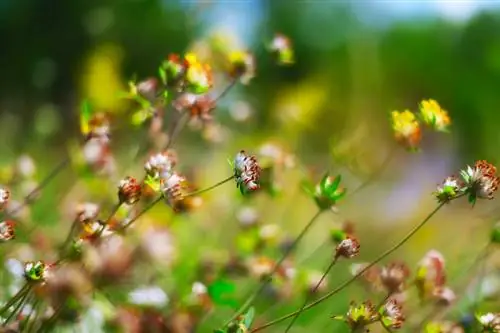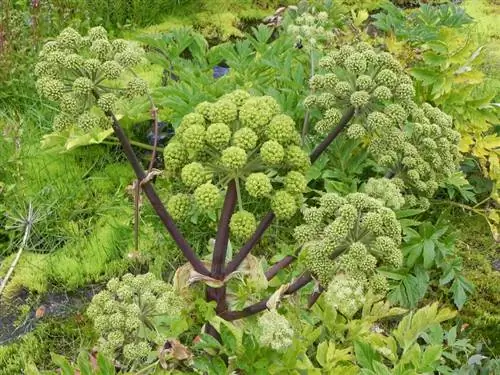- Author admin [email protected].
- Public 2023-12-25 17:45.
- Last modified 2025-01-23 11:22.
Opinions differ when it comes to sorrel. Proponents warmly welcome the delicate plant with its distinctive leaves, while opponents vehemently fight it as a weed. Both parties will receive useful answers to frequently asked questions about sorrel species here.

What are the most important points in caring for sorrel?
Sorrel is a plant that is valued both as an ornamental and medicinal plant and as a weed control plant. It prefers light shade, low-lime and fresh, moist soil and can be encouraged by watering with lime-free water and fertilizing.
Planting sorrel correctly
The majority of sorrel species come from the tropical regions of the world, so they are cultivated as annuals. Wood sorrel (Oxalis acetosella), on the other hand, has a creeping, richly branching rhizome as a survival organ, making this species suitable as a ground cover. In addition, this sorrel has been used as a medicinal and herbal plant for generations. How to plant correctly:
- In May, choose a location in light shade, with low-lime, humus-rich, fresh, moist soil
- Dig small pits at a distance of 12-15 cm to enrich the soil with compost
- Insert the potted young plants up to the bottom pair of leaves and water in soft water
- Plant bulbous sorrel approx. 5 cm deep in the substrate
Sorrel is often cultivated in decorative pots so that the leaves are ready to hand on the windowsill for use as a dish ingredient. Use acidic ericaceous soil as a substrate and insert a drainage system made of pottery shards above the water drain.
Care tips
The care program for wood sorrel presents less of a challenge for the gardener than combating it as a lawn weed. In order to use the positive attributes as an ornamental, medicinal and culinary herb, you only need to take the following aspects into account:
- Water sorrel regularly with lime-free water
- Fertilize organically from April to July
- Protect wood sorrel and other perennial species in winter with coniferous twigs and compost
Tropical clover beauties, such as Mexican lucky clover, look charming in pots. These sorrel species spend the winter on the bright windowsill at cool temperatures between 12 and 15 degrees Celsius.
Which location is suitable?
Sorrel prefers a location in light shade where no blazing sun can harm the delicate leaves and flowers. The plant feels at home in the protection of tall perennials and trees. Lucky clover and its relatives like to take a partially shaded spot on the balcony.
What soil does the plant need?
So that sorrel can fulfill its intended task to the fullest satisfaction, the only soil that is considered is a soil that is poor in lime. The soil should be nutrient-rich and fresh and moist. In the pot and balcony box, the plant does its best in ericaceous or rhododendron soil, enriched with lava granules or expanded clay for good permeability.
When is flowering time?
The delicate, white or pink flowers unfold from May to June. At this time, the content of ingredients is at its peak. After the visible flowers have withered, the hour of cleistogamous flowers arrives during the summer. These are buds that do not open. Here pollination takes place in the closed state. This circumstance most likely contributes to the ability of wood sorrel to spread explosively.
Cut wood sorrel correctly
If you are cultivating sorrel for use as an ornamental, medicinal or kitchen plant, the scissors are only used for harvesting the leaves. However, if you view the plants as weeds, consistent cutting will take away the edge of the clover in the long run. Repeatedly scything in the bed, mowing the lawn regularly and cutting along the slope with scissors drains the plant and prevents seeding.
Watering sorrel
Water sorrel in beds and pots only with lime-free water. Collected rainwater or decalcified tap water is ideal. If the irrigation water can be taken from a pond with nutrient-rich and soft water, there is no need to add fertilizer.
Fertilize sorrel properly
In an appropriate location with humus-rich, nutrient-rich soil, starting fertilization in April in the form of compost, horn shavings or nettle manure is usually sufficient. If deficiency symptoms are evident, such as yellowed leaves and stunted flowers, apply an organic fertilizer every 4 weeks. When grown in pots, wood sorrel happily accepts liquid fertilizer every 3 weeks from May to July.
Wintering
The vast majority of sorrel species come from subtropical countries and therefore have no frost hardiness whatsoever. Therefore, lucky clover and colleagues are either cultivated as an annual in the bed or in the pot. After the first frost, the above-ground parts of the plant all die off. Nevertheless, the mother plant took care of its continued existence in advance in the form of seedlings and underground runners. Therefore, cover these planting areas in the garden with coniferous twigs or compost so that sorrel can sprout again next season. Mexican lucky clover in a pot spends the winter on the bright windowsill at temperatures of 12 to 15 degrees. Wood sorrel cannot tolerate warmer temperatures and direct sun during overwintering.
Propagate sorrel
In order to grow more specimens, the focus is on propagation by division. This method works best with wood sorrel or other perennial species. In spring or fall, dig up a well-established plant, divide the rootstock and plant the segments in the soil in the new location. Direct sowing of seeds is possible from May if sufficient protection against pecking birds and voracious snails can be guaranteed.
Is wood sorrel poisonous?
It is a fairly high proportion of oxalic acid that qualifies wood sorrel as a slightly poisonous plant. If a large amount of this clover acid gets into the human or animal organism, this can lead to symptoms of poisoning. Nausea, vomiting and circulatory problems are to be feared, although the individual overdose depends on the respective physical constitution. For small animals, such as rabbits, even small quantities of sorrel pose a fatal danger, so this plant is not suitable as food.read more
How can wood sorrel be effectively combated in the lawn?
No one can be happy about clover in their lawn. Since wood sorrel is one of the most stubborn lawn weeds, combating it causes a lot of headaches for troubled gardeners. We have put together a brief overview of the most effective methods for you:
- In the early infestation stage, remove individual plants with the weed cutter
- Pick out larger patches of clover with a spade and repair them with lawn patches
- In the event of a clover invasion, mow the lawn briefly, scarify in a checkerboard pattern, lime and fertilize
- Cover the lawn area populated with sorrel with black foil for 6 to 8 weeks
If these four control methods come to nothing, the only option left is to resort to the chemical club. Suitable herbicides (€39.00 at Amazon) are Banvel M lawn weed killer from Compo or Anicon Ultra from Celaflor. These preparations kill sorrel without harming the noble lawn grasses.






